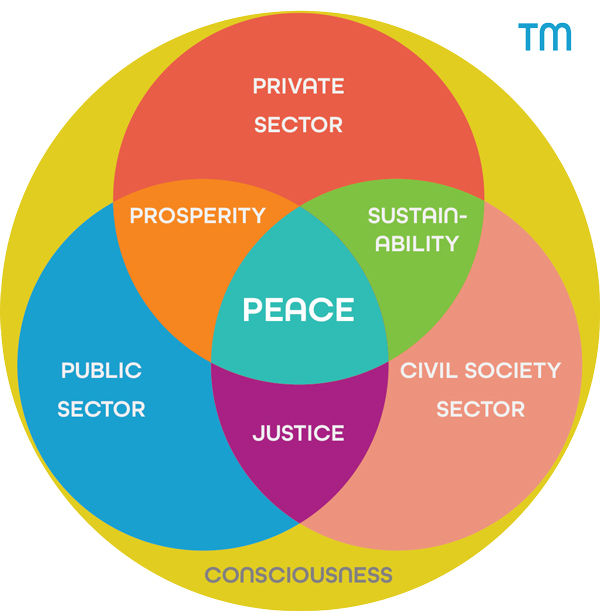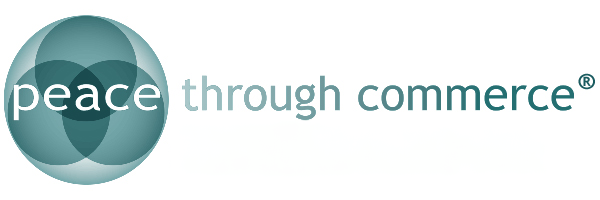Matrix of Peace Framework: Theory, Model, and Technology™

The Matrix of Peace
A multi-sector, whole-systems, consciousness model of society
to create just, prosperous, and sustainable societies
generating widespread flourishing of all life
[For education and training in the meaning and application of the Matrix of Peace, contact us at services@peacethroughcommerce.org]
The Matrix of Peace Whole Systems Model is a robust, multi-sector, consciousness model of society. Its purpose is to create an ecosystem of societal peace. Its goal is widespread flourishing of all life. Its parameters assume society is a conscious, dynamic, chaordic, intelligent, and progressive ecosystem, open to evolution, experimentation, creative growth, and decay.
Matrix theory provides a new, whole-systems knowledge base for designing and actualizing ecosystems of societal peace, grounded in the best practices of the classical liberal tradition and the human potential movement. Matrix technologies apply the theory and model through thought leadership, education, training, curation, convening, and other tools that foster ecosystems of societal peace.
Matrix model, theory, and technologies comprise three new integrated resources for societal building, peacebuilding, and problem-solving called “Matrix of Peace Systems™.” This knowledge base provides the scaffolding for a new geometry, science, philosophy, biology, ecology, and cosmology of society. We believe Matrix of Peace Systems contain within them the human operating code for building and maintaining ecosystems of societal peace.
Matrix of Peace Systems illuminate the peace-optimizing values and best practices for a society in its key sectors: public, private, and civil society. They lead people to understand problems like pandemics, poverty, war, inequality, and climate change from both human consciousness and best practices viewpoints.
The Matrix of Peace Whole Systems Model diagram of society is an entirely new and unique kind of map of society—a living systems map of its key human-based components—human actions in its public, private, and civil society sectors and its human consciousness forces—all visible, accounted for, and arranged according to a human operating code for building and maintaining ecosystems of societal peace. It is a living systems map of society expressed as society is in all its humanity—conscious, dynamic, chaordic, intelligent, and progressive, open to evolution, experimentation, creative growth, and decay.
Consciousness work focuses on values, virtues, beliefs, and worldviews. It finds areas of values-agreement and guides stakeholders to create new solutions to age-old problems from a different level of consciousness than that which created them. Best practices work focuses on existing practices in the public, private, and civil society sectors and compares them to best practices for generating justice, prosperity, and sustainability: the three necessary but sufficient conditions to maintain ecosystems of societal peace.
Matrix of Peace Systems bring together historically siloed and sometimes hostile sectors, finds shared values, and uses systems solutions to generate widespread flourishing of all life. This model is our creative gift and that of our family of society building and peacebuilding programs.
In sum, Matrix of Peace Systems serve three key functions for society building, peacebuilding, and problem-solving: as a: conscious, whole-systems theory, a diagrammatic model of society, and new technologies for applying the theory and model through thought leadership, education, training, consulting, convening, and curating Matrix-grounded work.
Matrix theory describes the Theory of Change and operations that lead to healthy ecosystems of societal peace generating widespread flourishing of all life. Matrix technologies operationalize Matrix Theory and Model in two disciplines as follows:
- Thought leadership, education and training. Matrix Theory and Modeling form a new knowledge base for society building, peacebuilding, and problem-solving. They are foundational as curriculum in these fields in k-12, graduate, and adult education. The Matrix Model provides a guide to the key component parts of society making up an ecosystem of societal peace: sectors, intersections, practices, and consciousness forces like values, beliefs, and worldviews. The Matrix Venn diagram visually and functionally illustrates the interworkings, overarching schema, and key concepts for building and maintaining ecosystems of societal peace. Matrix theory forms the basis for training Matrix practitioners, preparing citizens to be Matrix-thinkers, and preparing youth to be future-ready to achieve peaceful, prosperous, and happy lives.
- Consulting, convening, and curating Matrix-grounded work. Matrix practitioners work from Matrix design goals for building sustainable, just, and prosperous societies capable of achieving ecosystems of societal peace. They use a Matrix of Peace Whole Systems Methodology and Facilitation Tool for conscious, whole-systems society building, peacebuilding, and problem-solving. They incorporate the Matrix model as a diagnostic and simulation tool to assess and address conditions leading to societal problems. These processes lead to gap analysis and whole-systems solution generation.
The Goal of Matrix of Peace Systems: Creating Ecosystems of Societal Peace Generating Widespread Flourishing of All Life
The goal of Matrix of Peace Systems is to create ecosystems of societal peace generating widespread flourishing of all life. A Matrix definition of societal peace is operational and grounded in both systems thinking and Matrix mapping: that time when society is generating sufficient outcomes of justice, prosperity, and sustainability to maintain an ecosystem of societal peace. Societal peace is fed by peace-optimizing values and virtues such as love, compassion, and empathy. It is self-organizing and self-correcting, and forms the center superordinate intersection on the Matrix of Peace Whole Systems Model of Society.
Matrix of Peace theory predicts sustainable societal peace ensues from well-functioning public, private, and civil society sectors co-operating (not merely operating) from a field of shared values to co-generate justice, prosperity, and sustainability–the foundations of societal peace. Like a strong three-legged stool, justice, prosperity, and sustainability are all necessary to support sustainable peace. If any one of them is missing, peace will fail to be sustainable. It will also fail without the nourishing consciousness forces of peace-optimizing values and virtues. But when justice, prosperity, sustainability and peace-optimizing consciousness forces are present, the society will be capable of operating as an ecosystem of societal peace and widespread flourishing of all life.
The Matrix model is a roadmap to peace. You work your way from the outside circles through the intersections until you arrive at the superordinate intersection of societal peace. The visual model shows the intersections of justice, prosperity, and sustainability are the gateways to peace. The Matrix posits that no one or two outcomes alone can generate the superordinate intersection of societal peace. It takes all three outcomes–justice, prosperity, and sustainability–nourished by peace-optimizing values and virtues to co-generate societal peace.
A Matrix society operates as a well-designed, self-organizing, self-correcting ecosystem. It is not dependent upon coercion, violence, or force, but rather upon free will, voluntary action, and shared peace-optimizing values, virtues, beliefs, worldviews, and practices. Citizens within the ecosystem don’t have to be intending to create peace at all. If they are going about their daily activities in a well-designed ecosystem, the totality of their actions will co-generate societal peace naturally.
But the larger ecosystem is intentional. It requires well-designed organizational and mediating structures based on the best practices of the classical liberal tradition and human potential movement. The Matrix model recognizes it is mapping a living system which is conscious, dynamic, chaordic, intelligent, and progressive, open to evolution, experimentation, creative growth, and decay.
In this worldview, peace is not a static goal but rather a means to an end leading to widespread flourishing for all life. Communities do not achieve a “state of peace,” they achieve an “ecosystem of peace,” where peace is the ongoing outcome of a healthy, well-functioning society. It is fed by peace-optimizing values and virtues such as love, compassion, and empathy. By becoming well versed in Matrix whole systems thinking, key stakeholders can tackle community development in a way that generates sustainable, long-term peace.
Story Behind the Peace Through Commerce and the Matrix
The Matrix of Peace Whole Systems Model of Society™ was developed by Peace Through Commerce, Inc. It was at a retreat on April 14, 2011 that the Matrix model emerged into the Venn diagrammatic model of society it is today. This all came about after Peace Through Commerce launched as a standalone nonprofit from parent nonprofit Freedom Lights Our World, Inc. (“FLOW”)®, co-founded by John Mackey (CEO and co-founder of Whole Foods Market) and Michael Strong (author and educational entrepreneur) along with founding management team members Philomena Blees and the late Jeff Klein. Susan Niederhoffer, Vidar Jorgensen, and James Von Ehr rounded out the initial board of directors and its thought leaders.
The FLOW founding team was frustrated by widespread public unawareness of the power of entrepreneurial capitalism to transform poverty and violence into peace and prosperity. They strove to evolve the public’s understanding of capitalism’s role in problem solving and peacebuilding by emphasizing its ability to operate at higher order levels of consciousness embracing values of love, compassion, empathy, and social and environmental consciousness. From these roots, the founding team at Peace Through Commerce developed the Matrix of Peace Whole Systems Model of Society.
The new corporation was formed November 9, 2010. The first board of directors were:
-
- Joyce Beck
- Philomena Blees
- Felora Derakhshani
- Nitsan Gordon
- Barbara Jenkins
- Teri Johnson-Sapp
